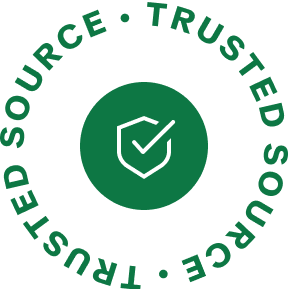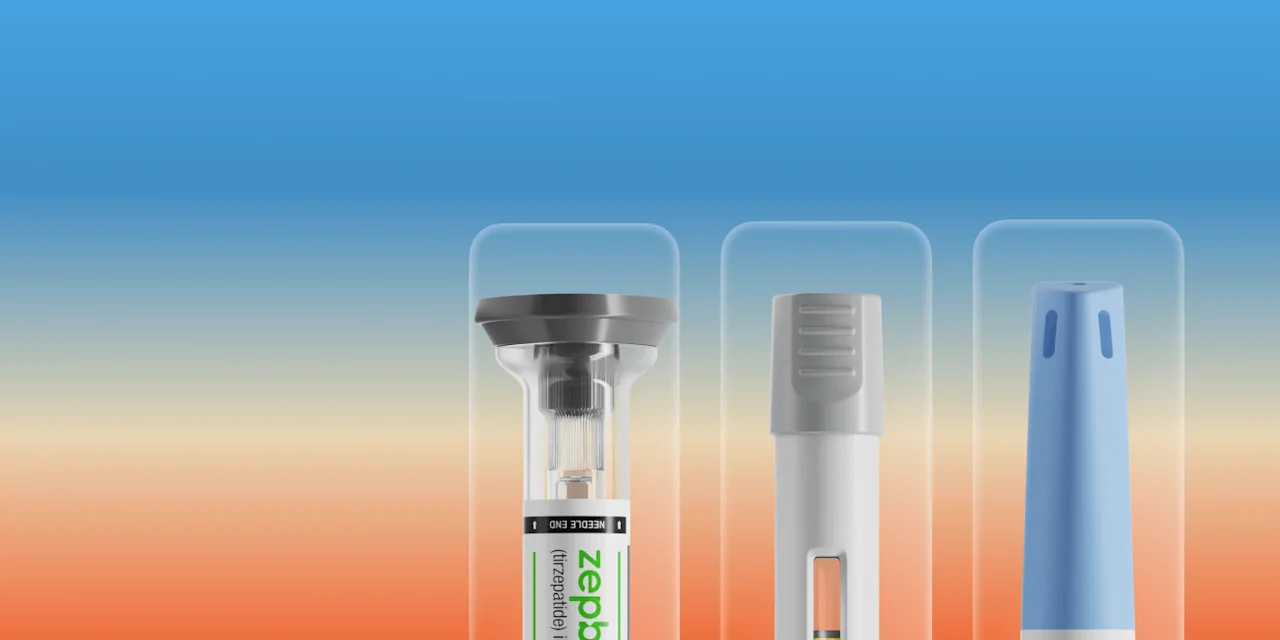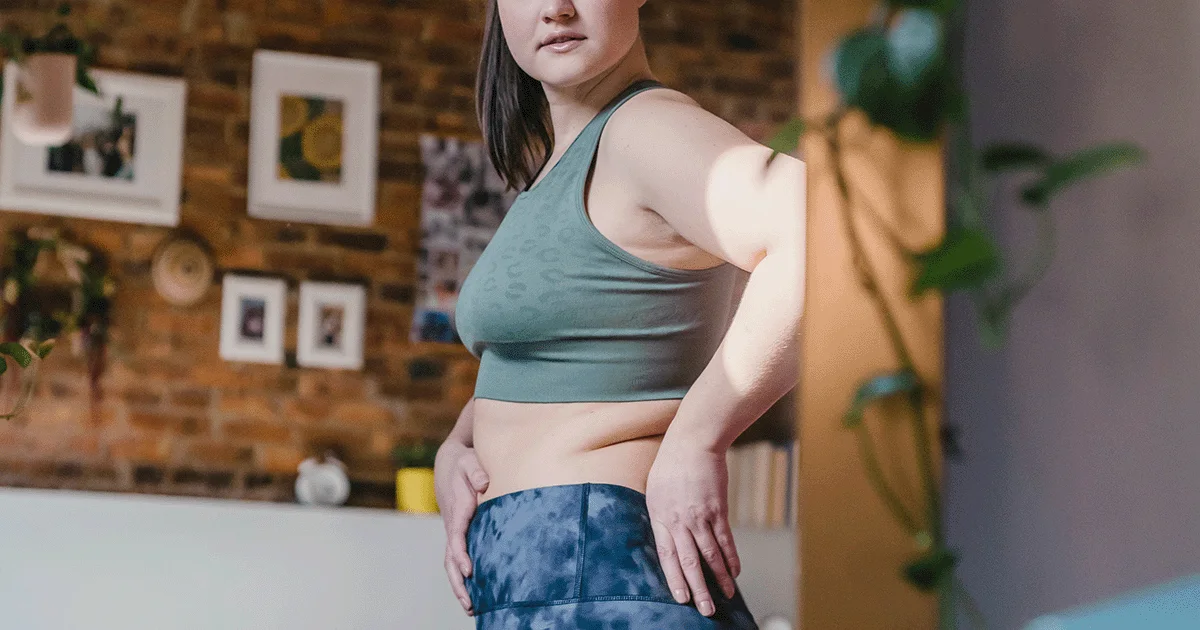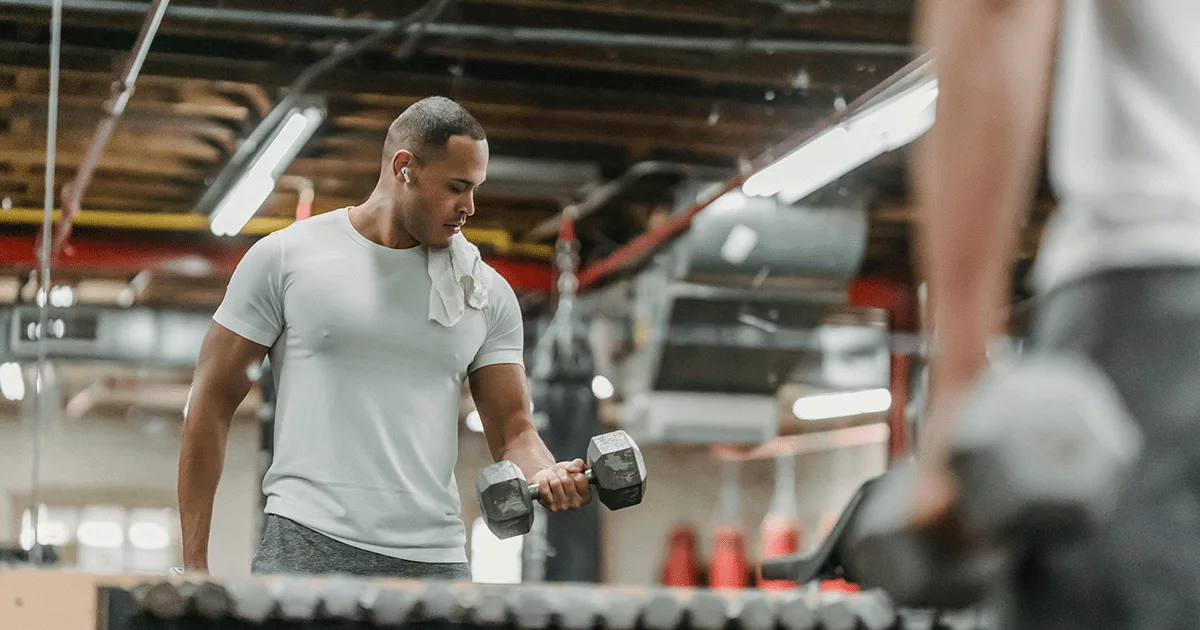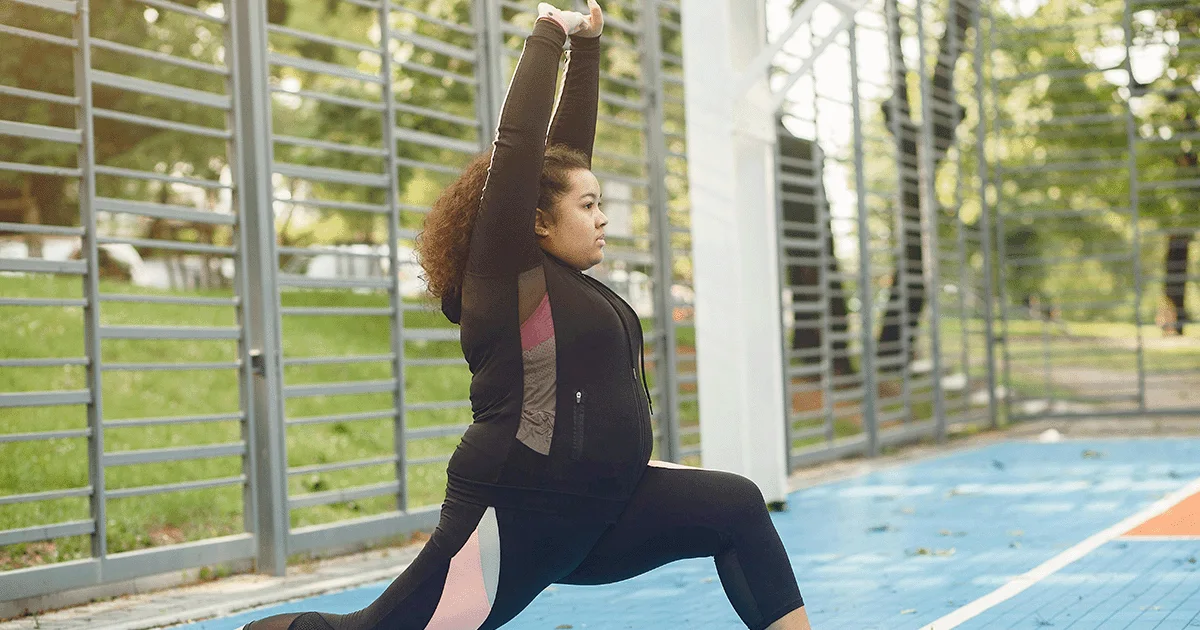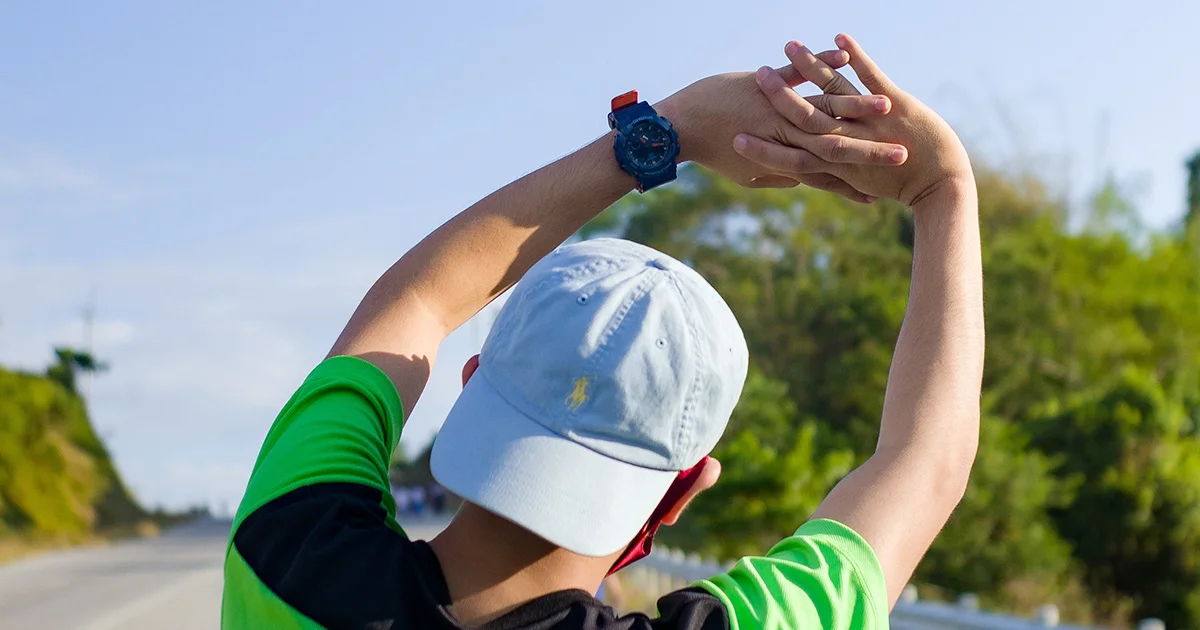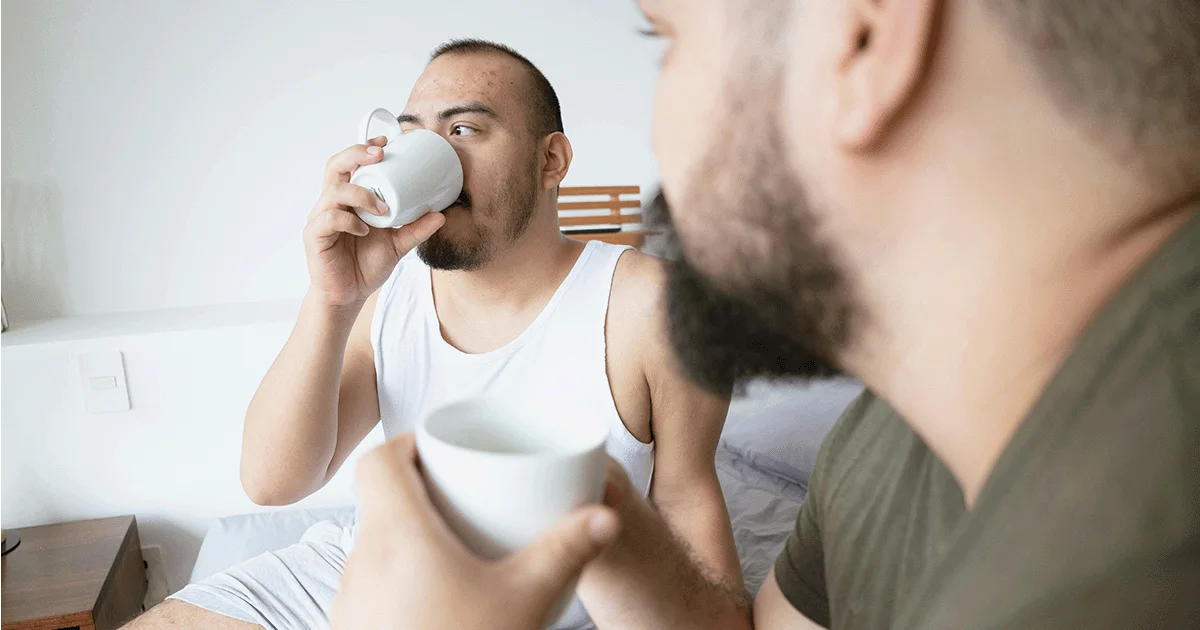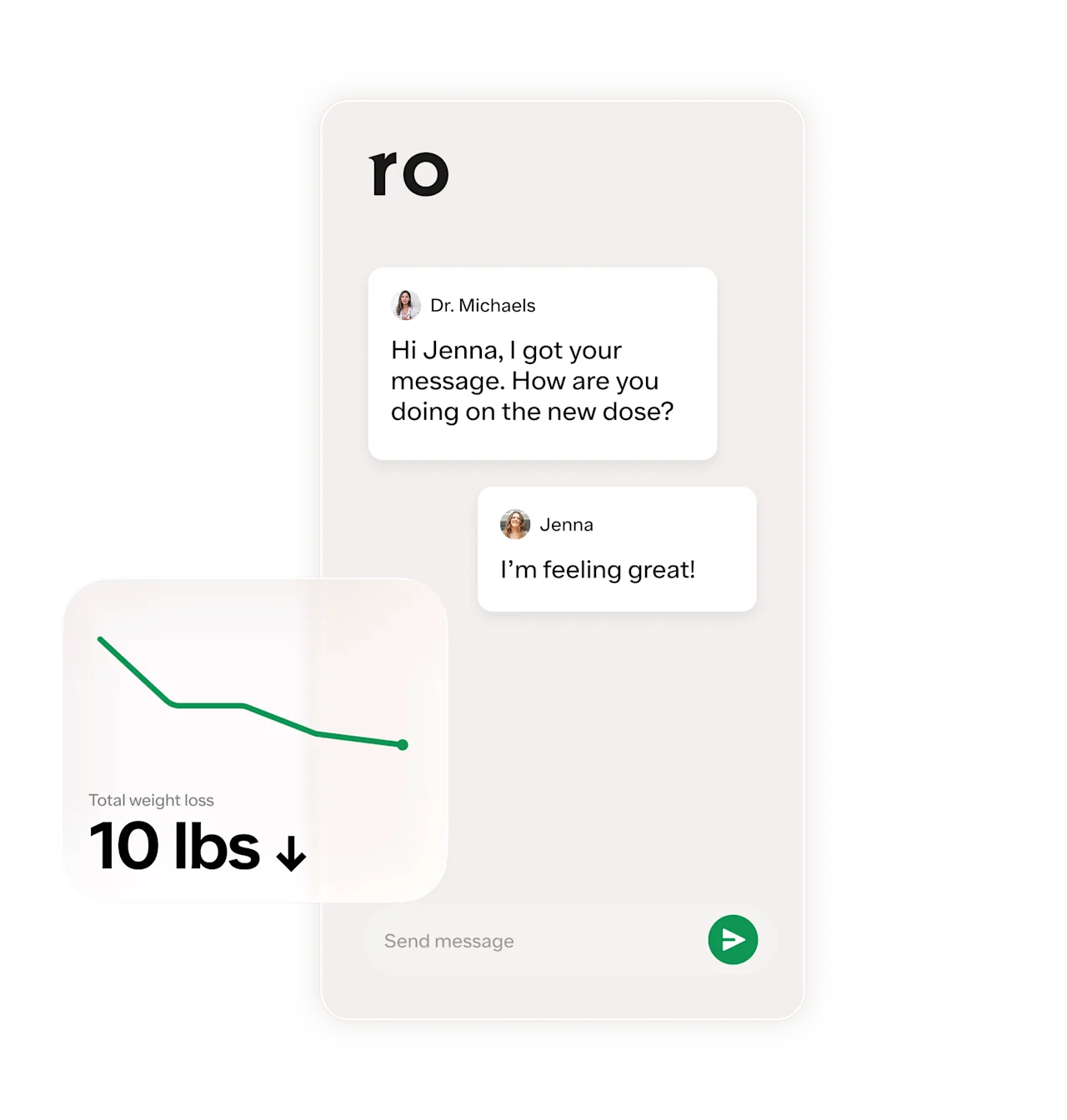Key takeaways
There’s no official Zepbound diet plan, but the medication should be taken alongside a reduced-calorie diet and exercise.
When taking Zepbound, focus on whole foods high in protein, fiber, and healthy fats to preserve muscle, stave off hunger, and fuel your body during weight loss.
Eating plenty of fruits and vegetables, lean proteins (such as fish), and whole grains can help maximize the effects of Zepbound and support your weight loss goals.
It’s generally recommended you avoid processed, fried, and sugary foods or drinks that can interfere with weight loss and worsen the drug’s gastrointestinal side effects.
Here's what we'll cover
Key takeaways
There’s no official Zepbound diet plan, but the medication should be taken alongside a reduced-calorie diet and exercise.
When taking Zepbound, focus on whole foods high in protein, fiber, and healthy fats to preserve muscle, stave off hunger, and fuel your body during weight loss.
Eating plenty of fruits and vegetables, lean proteins (such as fish), and whole grains can help maximize the effects of Zepbound and support your weight loss goals.
It’s generally recommended you avoid processed, fried, and sugary foods or drinks that can interfere with weight loss and worsen the drug’s gastrointestinal side effects.
The prescribing information for Zepbound (tirzepatide) says that the medication should be used in combination with “a reduced-calorie diet and increased physical activity.” But it doesn’t go into detail on what to eat on Zepbound (or what not to eat, for that matter). So, beyond consuming less overall, what else can you do to support your weight loss journey on Zepbound? Is there a recommended Zepbound diet plan you can follow?
The short answer is no. While there’s no official Zepbound diet, there are some foods you may want to eat more of when taking Zepbound, and some you may want to eat less. We reviewed the research and asked experts to share their best diet advice for Zepbound users.
Is there a recommended Zepbound diet plan?
No, there is no recommended Zepbound diet plan. But the drug is meant to be used in combination with a reduced-calorie diet and regular exercise. Limiting your caloric intake is the most straightforward way to lose weight, according to research. And that may be easier for people taking Zepbound, thanks to how the drug works.
As a refresher, Zepbound is a dual GIP/GLP-1 receptor agonist. Those acronyms stand for glucose-dependent insulinotropic polypeptide (GIP) and glucagon-like peptide-1 (GLP-1), two gut hormones produced naturally by your body. By mimicking these hormones and targeting their receptors, drugs like Zepbound can increase feelings of fullness, slow down digestion, and rebalance your appetite—all of which lead to weight loss.
In essence, Zepbound makes you feel full sooner and longer, which makes it easier to eat less and lose weight. In clinical trials, people taking Zepbound have lost up to 21% of their body weight in 72 weeks, especially at higher doses.
However, successful long-term weight loss is not just about eating less. It’s also about making sure the food you do eat gives you the nutrition you need to support your new lower body weight, says Paul T. Jaeckel, MS, RDN, CDN, LD, a private practice dietitian at Paul Jaeckel Nutrition.
“The reason why we need to add or reduce food groups is that appetite will decrease on Zepbound, so we need to make sure that there are enough nutrients being consumed (not the same as calories),” Jaeckel says. “The main point here is that you need to eat enough food to provide your body with the energy and nutrients needed, even when trying to lose weight.”
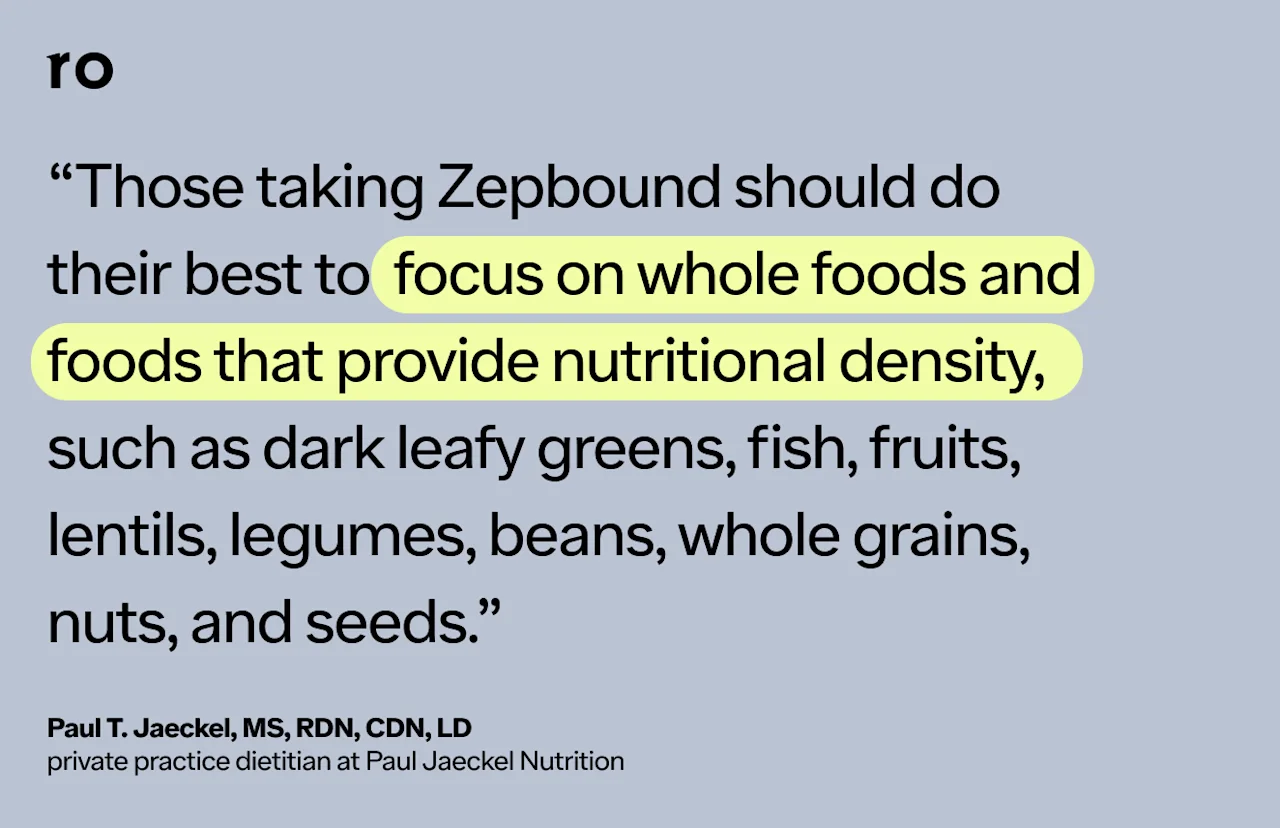
What to eat on Zepbound
“Those taking Zepbound should do their best to focus on whole foods and foods that provide nutritional density, such as dark leafy greens, fish, fruits, lentils, legumes, beans, whole grains, nuts, and seeds,” Jaeckel says. “These foods tend to provide multiple macronutrients, such as healthy, unsaturated fats and fiber.”
For someone taking Zepbound, Jaeckel recommends focusing on a diet rich in three key components: high-quality lean protein, fiber, and healthy fats. Let’s take a look at how each of these nutrients can support your treatment and what are considered some of the best sources—i.e. foods—to include in a Zepbound diet plan.
Lean protein
Protein offers a one-two punch for those looking to lose weight: It increases satiety (fullness) while also helping you build and maintain muscle mass. Plus, your body uses more energy to burn protein as fuel, which can further aid weight loss.
Fast weight loss, as can happen with Zepbound, often comes with some degree of muscle loss, says Claudia Hleap-Knight, RD, CDCES, owner of Hleap Nutrition, a nutrition practice in Philadelphia. Consuming a high-protein diet—while maintaining a regular exercise routine—can help minimize this effect or even prevent it from happening in the first place, she explains.
“Prioritizing protein helps maintain a healthy metabolism and supports long-term weight loss,” says Erin Palinski-Wade, RD, CDCES, LDN, CPT, a New Jersey-based dietitian and author of 2 Day Diabetes Diet. She recommends getting 20%–25% of your total daily calories from lean protein, and including a good source of protein at every meal and snack.
So, what kinds of foods are considered good sources of lean protein? Hleap-Knight recommends the following:
Poultry (e.g. chicken, turkey)
Seafood
Bone broth
Eggs
Low-fat dairy (e.g. Greek yogurt)
Tofu
Beans, legumes (e.g. edamame, lentils)
Bean-based pasta
You can also up the protein content of your meals with toppings like hemp seeds, flax, protein powder, and nutritional yeast, Hleap-Knight says. “[All] are subtly flavored natural food components that are easy to sneak into recipes for extra protein and fiber.”
Fiber (fruits and vegetables)
“It’s also important to boost your fiber intake by eating plenty of whole vegetables, fruits, beans, nuts, and seeds,” Palinski-Wade says. “These fiber-rich foods not only help prevent constipation—a common side effect of GLP-1s—but they also provide essential nutrients and antioxidants to help protect against deficiencies.”
Some research suggests that when losing weight, you should aim to get 45%–65% of your calories from carbohydrates, including 20–35 grams of fiber per day. Fiber increases feelings of fullness, in part because fiber-rich foods can take longer to chew but also since they’re more likely to fill up your stomach. Plus, fiber often shows up in foods that are lower in calories, such as fruits and vegetables, so you feel fuller even though you’re consuming fewer calories.
In a study of 345 people with obesity following a reduced-calorie diet (which is recommended when taking Zepbound), researchers found that those who ate more fiber lost more weight. They were also more likely to stick to their macronutrient goals (e.g. eating a healthy amount of fat and protein with each meal from a healthy variety of foods).
Good examples of fibrous foods include:
Berries
Pears
Apples
Leafy greens (e.g. spinach, kale)
Broccoli
Carrots
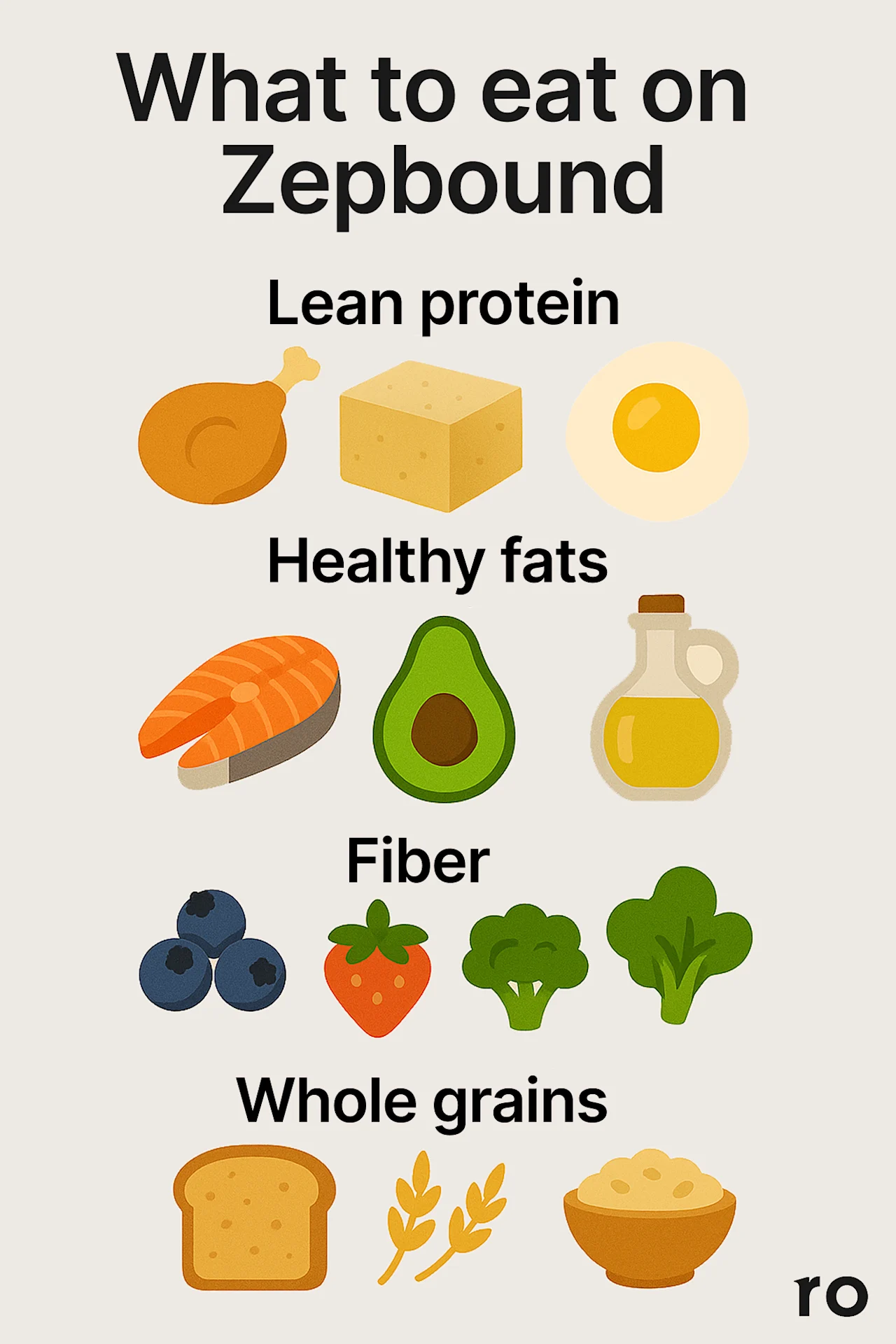
Healthy fats
It may feel counterintuitive, but it’s true: Fat can be good for you! You just need to eat more healthy fats (see: unsaturated fat) instead of unhealthy fats (we’re looking at you, trans fat and saturated fat). When losing weight, some experts recommend getting 20%–35% of your total caloric intake from monounsaturated and polyunsaturated fats.
Fat is energy-dense—even more so than protein or carbs—but your body burns more energy when metabolizing unsaturated fat than when metabolizing saturated fats, so you’re less likely to gain body fat when you eat it. It’s also been shown that swapping unhealthy fats for healthier ones can protect against weight gain and even lead to weight loss.
For example, in one study, replacing red meat with white meat or fish or replacing butter with olive oil led to small amounts of weight loss. And a long-term study found that replacing saturated and trans fats with unsaturated fat, especially polyunsaturated fat, can prevent age-related weight gain. (Due to a slowing metabolism, hormonal changes, and lifestyle shifts, the number on the scale can often increase with the number of candles on your birthday cake.)
Good sources of healthy fats include:
Nuts (especially walnuts)
Seeds (e.g. flax seeds, sunflower seeds)
Vegetable oils (e.g. canola oil, olive oil)
Fatty fish (e.g. salmon, tuna)
Whole grains
Similar to fats, carbohydrates are another macronutrient that’s been unfairly maligned. Like unsaturated fats, healthy carbs can be good for you. Whole grains are a great example.
Unlike refined grains (which are the type of carb you find in white bread, white rice, and pastries), whole grains contain a host of healthy ingredients, including fiber, vitamins, and minerals. As a result, eating more whole grains, compared to refined grains, is linked to a lower risk of obesity, heart disease, diabetes, and even cancer. And they promote feelings of fullness, which can help you avoid overeating while losing weight on Zepbound.
Good sources of whole grains include:
Brown rice
Barley
Whole-wheat bread
Whole-wheat, low-sugar cereal
Wheat bran
What to avoid eating on Zepbound
No foods are officially “off-limits” when taking Zepbound, but avoiding or limiting your intake of certain foods may make it easier to lose weight, ease the drug’s gastrointestinal side effects (e.g. diarrhea, nausea, vomiting), or both.
Foods high in saturated and trans fats
As the so-called “unhealthy” fats, it’s a good idea to limit your intake of saturated fats and trans fats while taking Zepbound. Eating more of these tends to lead to more weight gain, while replacing them with unsaturated fats tends to prevent weight gain. Plus, foods high in saturated fats can worsen any nausea you experience while taking Zepbound.
Saturated fat can impair your gut health, which is associated with obesity, chronic inflammation, and heart disease. Ideally, these fats should represent no more than 10% of your daily caloric intake. When taking Zepbound, consider limiting foods such as:
Baked goods (e.g. donuts, danishes)
Fatty or processed meats (e.g. bacon, sausage, cheeseburgers)
Whole-fat dairy products (e.g. butter, ice cream)
Coconut or palm oils
Fried foods
It’s worth noting that frying is inherently an unhealthy cooking method. It replaces the water content in a food with fat, and deep-frying food increases its trans fat content. Fried foods are linked to weight gain and belly fat, so it’s generally a good idea to avoid them when taking Zepbound. Plus, they may worsen some of Zepbound’s side effects, including heartburn.
High-sodium foods
“Some of the foods that we should limit when taking Zepbound are simply the calorie-dense foods with poor nutritional quality,” says Jaeckel. High-sodium foods are a good example, as they tend to be high in salt and calories, and low in fiber, protein, and essential vitamins and nutrients.
Eating too much sodium can be bad for your heart and kidney, as it can raise your risk of both cardiovascular disease and chronic kidney disease. When it comes to weight loss on GLP-1s like Zepbound, higher-sodium foods can increase bloating and GI distress, which are common side effects of the drug.
Sugary foods and drinks
Bites and beverages that are full of added sugars tend to be calorie-dense and offer little in the way of nutrition. Examples include candy, soda, and sweetened teas, among many others.
Palinski-Wade recommends avoiding these common sources of empty calories. “These foods provide little to no nutritional value and limited satiety, making it easy to exceed your calorie needs and slow your weight loss progress.”
What’s more, sugary foods and drinks can cause a rapid rise in blood sugar levels, which could stall your weight loss efforts and ability to experience results on Zepbound. They’ve also been shown to trigger or worsen common digestive side effects of GLP-1s.
Alcohol
In reviews of Zepbound, people sometimes report losing their taste for alcohol. That may be a good thing, since alcohol can exacerbate certain side effects of Zepbound, including heartburn and diarrhea.
Drinking alcohol can also disrupt your weight loss journey. When you drink, you are more likely to eat more food and calories, according to a meta-analysis of 22 studies.
Zepbound diet plan tips
A healthy Zepbound diet goes beyond focusing on what to eat and what not to eat on the medication. Here are a few more tips for creating and maintaining a well-rounded diet plan that supports your treatment journey.
Eat smaller meals more often
“When taking Zepbound or any other GLP-1 medication, eating habits can change dramatically,” Jaeckel says.
Someone who normally consumes two large meals a day may find themselves physically unable to do so once they start taking Zepbound, as the drug slows digestion and makes them feel full sooner.
“My biggest push for clients taking any kind of GLP-1 medication is to eat smaller meals, more often,” Jaeckel says. “This allows the body to have regular hunger and satiety cycles while giving enough time to digest the food.”
The eat-less, more-often strategy is often recommended for people taking GLP-1s as it can also help alleviate some of the gastrointestinal distress caused by these drugs.
Track your macros
Palinski-Wade recommends that her clients on GLP-1s track their daily food intake. “This helps ensure they’re meeting their nutritional needs—especially protein—to minimize muscle loss and reduce unwanted side effects,” she explains.
Paying attention to ingredient lists and nutrient content may help you more easily identify foods you should avoid on Zepbound, as many processed foods tend to be high in calories and sugar.
Eat mindfully
Eating mindfully is the practice of bringing mindfulness meditation to your meal. In general, mindfulness is about paying attention to what’s going on in that moment and accepting it as it is without judgment.
With food, mindfulness is about giving that same attention and acceptance to your meal. Before each bite, you can look at and observe your meal. Then, you can take a bite and notice how it tastes and feels in your mouth as you chew. After you swallow, you can take a moment to savor the taste.
Various studies have found that combining mindful eating with a weight loss regimen can lead to more success. People who eat mindfully tend to be less likely to binge or emotionally eat and may even lose more weight over time.
Stay hydrated
More research is still needed, but a number of studies have found that increasing your water intake—whether through drinking more overall, drinking water before a meal, or replacing caloric drinks with water—can lead to more weight loss.
Staying hydrated can also relieve some of Zepbound’s side effects, such as diarrhea and constipation.
“The best thing you can do to prevent constipation is to stay hydrated and consume enough fiber throughout the day,” Hleap-Knight says. “Even if you are going to the bathroom without any problems, it’s essential for energy, appetite, and gastrointestinal health to get enough of both of these things.”
Bottom line
While there’s no one-size-fits-all diet for people taking Zepbound, tailoring your eating habits to support your body’s needs can help you lose weight in a healthy, sustainable way.
There’s no official Zepbound diet, but what you eat can play a significant role during your treatment. Experts agree that adopting a reduced-calorie diet filled with nutritious whole foods can enhance the medication’s effects and support your long-term health.
Prioritize protein, fiber, and healthy fats. These nutrients can help you feel fuller longer, and protein preserves muscle mass, which you need for a healthy metabolism.
Cut back on unhealthy fats, fried foods, alcohol, and sugary drinks and foods. These types of items can contribute to weight gain and digestive distress on Zepbound.
Change how you eat, not just what you eat. Smaller, more frequent meals can help reduce side effects like nausea and bloating, while mindful eating practices can stop you from overeating.
Frequently asked questions (FAQs)
What should I be eating while on Zepbound?
Zepbound should be used in combination with a reduced-calorie diet. To ensure you get adequate nutrients while supporting healthy weight loss, Hleap-Knight recommends focusing on whole foods, such as lean proteins, beans, fruits, vegetables, and whole grains, while limiting your intake of ultra-processed foods, such as greasy, fried foods and those with added sugars.
What should you eat for breakfast on Zepbound?
Baked egg bites, a yogurt cup with granola, or overnight oats can all be good choices for breakfast on Zepbound, according to Jaeckel. These “quick and easy” options can all be paired with fruits of your choice, prepared ahead in a batch if you’re busy, and shouldn’t cause any GI upset—plus, they provide a good source of protein and fiber to start your day, he explains.
What should you eat before a Zepbound injection?
There are no specific foods you need to eat before a Zepbound injection. Zepbound can be injected at any time of day, with or without meals. The important part is to remember to inject Zepbound on the same day of the week each week, and to rotate through the injection sites (upper arm, thigh, or abdomen) with your injection.
How can you maximize weight loss on Zepbound?
Zepbound should be used in combination with diet and exercise. To maximize weight loss on Zepbound, increase your physical activity and change up your eating habits. Focus on whole foods with a good amount of fiber, protein, and healthy fats, and avoid processed foods and sugary snacks and drinks.
What can’t I eat on Zepbound?
“There is no need to entirely avoid any foods while taking Zepbound,” Hleap-Knight says. “Ideally, you want to consume a balanced diet that supports your macronutrient and fiber requirements, while reducing added fats and sugar in your diet.” If you’re experiencing gastrointestinal side effects like nausea, belching, or heartburn, experts recommend avoiding alcohol, carbonated drinks, and any fatty, fried, or processed foods.
DISCLAIMER
If you have any medical questions or concerns, please talk to your healthcare provider. The articles on Health Guide are underpinned by peer-reviewed research and information drawn from medical societies and governmental agencies. However, they are not a substitute for professional medical advice, diagnosis, or treatment.
Zepbound Important Safety Information: Read more about serious warnings and safety info.
GLP-1 Important Safety Information: Read more about serious warnings and safety info.
References
Beulen, Y., Martínez-González, M. A., van de Rest, O., et al. (2018). Quality of Dietary Fat Intake and Body Weight and Obesity in a Mediterranean Population: Secondary Analyses within the PREDIMED Trial. Nutrients, 10(12), 2011. doi: 10.3390/nu10122011. Retrieved from https://pmc.ncbi.nlm.nih.gov/articles/PMC6315420/
Bracamontes-Castelo, G., Bacardí-Gascón, M., & Jiménez Cruz, A. (2019). Effect of water consumption on weight loss: a systematic review. Nutricion Hospitalaria, 36(6), 1424–1429. doi: 10.20960/nh.02746. Retrieved from https://pubmed.ncbi.nlm.nih.gov/31657610/
Eli Lilly. (2024). Highlights of Prescribing Information: Zepbound (tirzepatide) injection, for subcutaneous use. Retrieved from https://pi.lilly.com/us/zepbound-uspi.pdf
Eli Lilly. (2025). Your weekly Zepbound routine. Retrieved from https://zepbound.lilly.com/weight/how-to-use
Gorgojo-Martínez, J. J., Mezquita-Raya, P., Carretero-Gómez, J., et al. (2022). Clinical Recommendations to Manage Gastrointestinal Adverse Events in Patients Treated with Glp-1 Receptor Agonists: A Multidisciplinary Expert Consensus. Journal of Clinical Medicine, 12(1), 145. doi: 10.3390/jcm12010145. Retrieved from https://pmc.ncbi.nlm.nih.gov/articles/PMC9821052/
Jastreboff, A. M., Aronne, L. J., Ahmad, N. N., et al. (2022). Tirzepatide once weekly for the treatment of obesity. New England Journal of Medicine, 387(3), 205–216. doi: 10.1056/nejmoa2206038. Retrieved from https://www.nejm.org/doi/full/10.1056/NEJMoa2206038
Kim, J. Y. (2021). Optimal Diet Strategies for Weight Loss and Weight Loss Maintenance. Journal of Obesity & Metabolic Syndrome, 30(1), 20–31. doi: 10.7570/jomes20065. Retrieved from https://pmc.ncbi.nlm.nih.gov/articles/PMC8017325/
Kramer, H. (2019). Diet and chronic kidney disease. Advances in Nutrition, 10, S367–S379. doi: 10.1093/advances/nmz011. Retrieved from https://www.sciencedirect.com/science/article/pii/S2161831322002241?via%3Dihub
Kwok, A., Dordevic, A. L., Paton, G., et al. (2019). Effect of alcohol consumption on food energy intake: a systematic review and meta-analysis. British Journal of Nutrition, 121(5), 481–495. doi: 10.1017/S0007114518003677. Retrieved from https://www.cambridge.org/core/journals/british-journal-of-nutrition/article/effect-of-alcohol-consumption-on-food-energy-intake-a-systematic-review-and-metaanalysis/2F9AB5C64A86329EB9E817ADAEC3D88C
Liu, X., Li, Y., Tobias, D. K., et al. (2018). Changes in Types of Dietary Fats Influence Long-term Weight Change in US Women and Men. The Journal of Nutrition, 148(11), 1821–1829. doi: 10.1093/jn/nxy183. Retrieved from https://pmc.ncbi.nlm.nih.gov/articles/PMC6209808/
Martini, D., Godos, J., Bonaccio, M., et al. (2021). Ultra-Processed Foods and Nutritional Dietary Profile: A Meta-Analysis of Nationally Representative Samples. Nutrients, 13(10), 3390. doi: 10.3390/nu13103390. Retrieved from https://pmc.ncbi.nlm.nih.gov/articles/PMC8538030/
MedlinePlus-a. (2024). Facts about monounsaturated fats. Retrieved from https://medlineplus.gov/ency/patientinstructions/000785.htm
MedlinePlus-b. (2024). Facts about polyunsaturated fats. Retrieved from https://medlineplus.gov/ency/patientinstructions/000747.htm
MedlinePlus-c. (2024). Facts about saturated fats. Retrieved from https://medlineplus.gov/ency/patientinstructions/000838.htm
Miketinas, D. C., Bray, G. A., Beyl, R. A., et al. (2019). Fiber Intake Predicts Weight Loss and Dietary Adherence in Adults Consuming Calorie-Restricted Diets: The POUNDS Lost (Preventing Overweight Using Novel Dietary Strategies) Study. The Journal of Nutrition, 149(10), 1742–1748. doi: 10.1093/jn/nxz117. Retrieved from https://pmc.ncbi.nlm.nih.gov/articles/PMC6768815/
Moon, J. & Koh, G. (2020). Clinical Evidence and Mechanisms of High-Protein Diet-Induced Weight Loss. Journal of Obesity & Metabolic Syndrome, 29(3), 166–173. doi: 10.7570/jomes20028. Retrieved from https://pmc.ncbi.nlm.nih.gov/articles/PMC7539343/
Moreno-Franco, B., Rodríguez-Ayala, M., Donat-Vargas, C., et al. (2021). Association of Cooking Patterns with Inflammatory and Cardio-Metabolic Risk Biomarkers. Nutrients, 13(2), 633. doi: 10.3390/nu13020633. Retrieved from https://pmc.ncbi.nlm.nih.gov/articles/PMC7919797/
Nelson, J. B. (2017). Mindful Eating: The Art of Presence While You Eat. Diabetes Spectrum: A Publication of the American Diabetes Association, 30(3), 171–174. doi: 10.2337/ds17-0015. Retrieved from https://pmc.ncbi.nlm.nih.gov/articles/PMC5556586/
Peng, A. W., Juraschek, S. P., Appel, L. J., et al. (2019). Effects of the DASH Diet and Sodium Intake on Bloating: Results From the DASH-Sodium Trial. The American Journal of Gastroenterology, 114(7), 1109–1115. doi: 10.14309/ajg.0000000000000283. Retrieved from https://pmc.ncbi.nlm.nih.gov/articles/PMC7122060/
Pepe, R. B., de Menezes Amorim Coelho, G. S., da Silva Miguel, F., et al. (2023). Mindful eating for weight loss in women with obesity: a randomised controlled trial. British Journal of Nutrition, 130(5), 911–920. doi: 10.1017/S0007114522003932. Retrieved from https://www.cambridge.org/core/journals/british-journal-of-nutrition/article/mindful-eating-for-weight-loss-in-women-with-obesity-a-randomised-controlled-trial/FEBA9D60A940E6FC5C1FAD6D5C0B2E2F
Sharma, S. P., Chung, H. J., Kim, H. J., & Hong, S. T. (2016). Paradoxical Effects of Fruit on Obesity. Nutrients, 8(10), 633. doi: 10.3390/nu8100633. Retrieved from https://pmc.ncbi.nlm.nih.gov/articles/PMC5084020/
Smethers, A. D. & Rolls, B. J. (2018). Dietary Management of Obesity: Cornerstones of Healthy Eating Patterns. The Medical Clinics of North America, 102(1), 107–124. doi: 10.1016/j.mcna.2017.08.009. Retrieved from https://pmc.ncbi.nlm.nih.gov/articles/PMC5726407/
Spadaro, K. C., Davis, K. K., Sereika, S. M., et al. (2017). Effect of mindfulness meditation on short-term weight loss and eating behaviors in overweight and obese adults: A randomized controlled trial. Journal of Complementary & Integrative Medicine, 15(2), /j/jcim.2018.15.issue-2/jcim-2016-0048/jcim-2016-0048.xml. doi: 10.1515/jcim-2016-0048. Retrieved from https://pubmed.ncbi.nlm.nih.gov/29211681/
Stinson, E. J., Piaggi, P., Ibrahim, M., et al. (2018). High Fat and Sugar Consumption During Ad Libitum Intake Predicts Weight Gain. Obesity (Silver Spring, Md.), 26(4), 689–695. doi: 10.1002/oby.22124. Retrieved from https://pubmed.ncbi.nlm.nih.gov/29504262/
Sun, X. & Du, T. (2023). Trends in weight change patterns across life course among US adults, 1988-2018: population-based study. BMC Public Health, 23(1), 2168. doi: 10.1186/s12889-023-17137-x. Retrieved from https://bmcpublichealth.biomedcentral.com/articles/10.1186/s12889-023-17137-x
Wei, X., Yang, W., Wang, J., et al. (2022). Health Effects of Whole Grains: A Bibliometric Analysis. Foods (Basel, Switzerland), 11(24), 4094. doi: 10.3390/foods11244094. Retrieved from https://pmc.ncbi.nlm.nih.gov/articles/PMC9777732/
